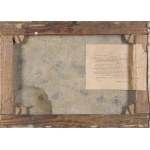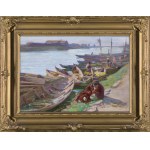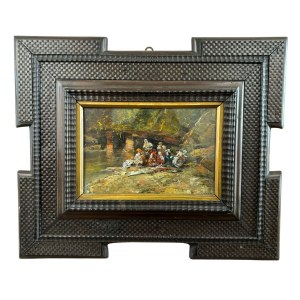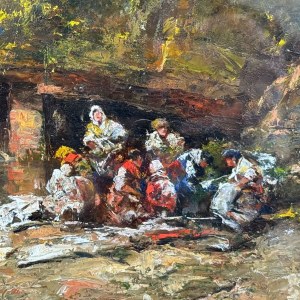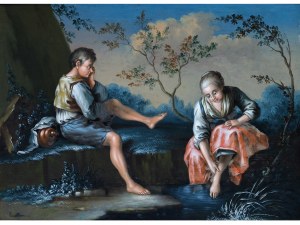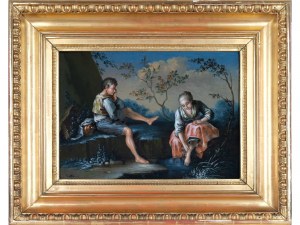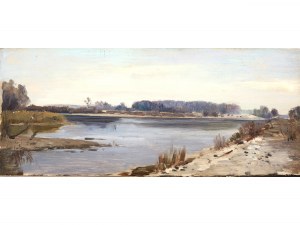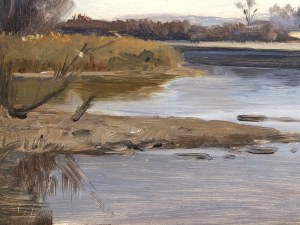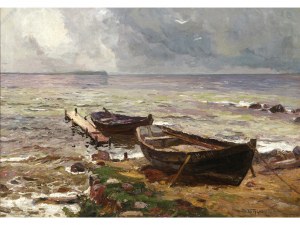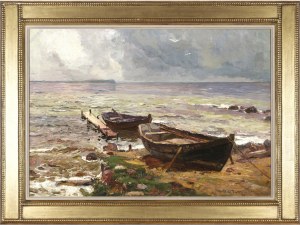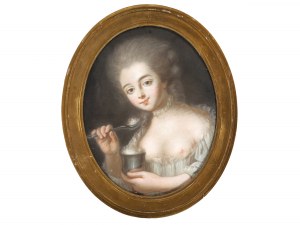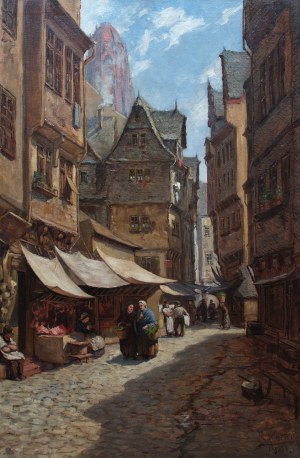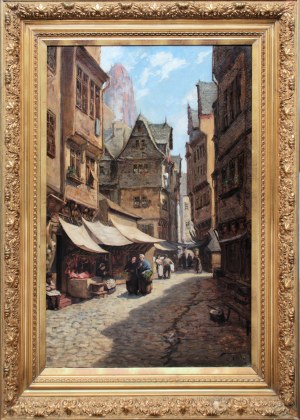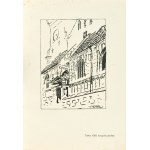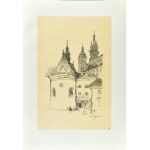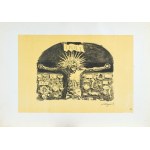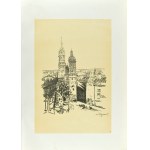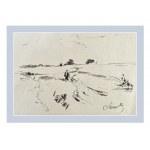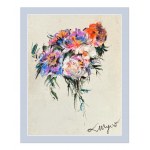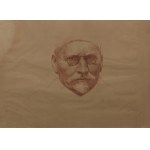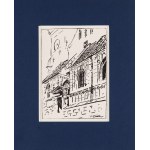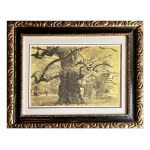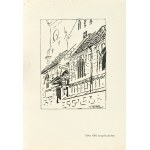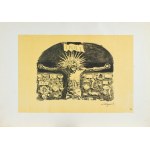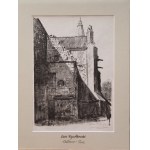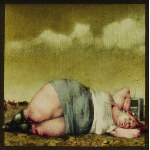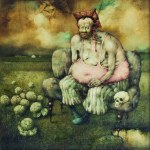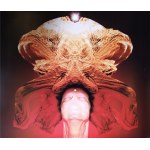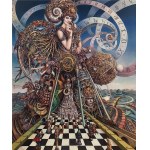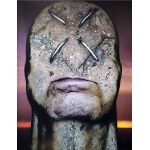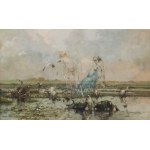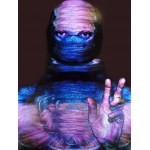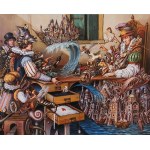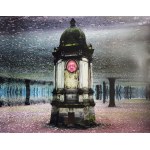34.7 x 48.5cm - oil, canvas signed p.d.: LWyczół | 1910.
On the reverse, on the l. strip of the loom (in pencil): Hr. Dzieduszycki | Lvov | [...] 5.; on the g. loom strip (in pencil): 14 - IX; next to a small fragment of a sticker of the TZSP in Warsaw (stamp): 30427; next to (in pencil): [...] 1938 | 2000 zl;
on the right loom strip and on the canvas, glued a typewritten sheet with the opinion of Dr. Kazimierz Buczkowski, dated January 1957, confirming the authenticity of the painting by Leon Wyczółkowski; on the bottom loom strip, opposite the composition, a barely legible inscription (in pencil): [...] | 11 - 1 | Mr. [...] | 2850; next to the number (in pencil): - 86.
The featured painting is an excellent example of the artist's fascination with the experimental use of sunlight. The free brushstrokes and luscious colors - emerald greens, soft purples - also highlight the virtuosity Wyczółkowski achieved in oil painting. Emphasizing the apotheosis of nature and work - filled with vibrant light and air - the artist presents his interpretation of Impressionism. From an early age, Wyczółkowski was fascinated by life and hard work in harmony with nature. This definitely distinguished his works from the Impressionists, who chose empty landscapes or light and pleasant scenes of city life as the subjects of their works. In this respect, Wyczółkowski remained a realist. Krystyna Kulig-Janarek and Waclawa Milewska, authors of the 2003 Krakow catalog, note that the painter embezzled from impressionism, in many cases not recognizing direct studies as final versions of the work. Wyczółkowski's Impressionism was also descriptive, he was concerned with realism in depicting people and nature, did not consistently follow the rules of chromaticism, recognized local colors and rarely used divisionism.
At the time when Boats on the River was created, Wyczółkowski intensified colors, he believed that in sunlight natural colors are lost, changed. He argued that the painter's eye should capture the colors imposed by the sun's rays and transfer them to the canvas. French Impressionists at this stage introduced theory into the creative process. They broke down the colors seen into a series of touches of complementary colors. Wyczółkowski, on the other hand, approached nature directly and with confidence in the truth that his eye presents to him. Paintings from this period are characterized by intense sapphire hues, garnets, shades of red and exceptionally blue parts of the sky. Wyczółkowski was definitely an open-air painter. Only by standing in the midst of nature could he grasp all the variables - the variety of colors depending on the effects of light, humidity, or dryness of the air.
One of the essential features of Wyczółkowski's talent is his great painterly flair and vitality, as well as his need for an immediate discharge of emotion. This is accompanied by sensitivity to changeable phenomena, to the beauty of the surface, without venturing into the depths and deepening it with reflection. (...) Wyczółkowski does not realize the type of some inner beauty that one carries within oneself, as, for example, Wyspianski does - he does not venture into the depths of himself and emerge from there, but reacts immediately to visual impressions and perpetuates them, pushed to do so by the need for constant activity. His compass in this act is his artistic emotion, which is supported by fabulous skill and extraordinary ease in mastering technical difficulties. So we will not look for emotional values in his paintings, sentiments, the lack of which is compensated by Wyczółkowski with other values. But for these they are undeniable and original and place him among our best artists. What he can afford to do, he does with all the energy, with the total passion of a man who does not spare himself, pathetically and with bravado, like someone who sincerely wants to move his fellows and give them his emotion. Wyczółkowski is a painter in flesh and blood, and with all his work he illustrates the precept that a painter's first duty is to paint. He is the type of painter gifted with sensitivity to sensual beauty, visible to all, while he characterizes it with great talent and conviction. You can see from his paintings that it moves and captivates him. He has an undeniable capacity for strong emotion (...) Wyczółkowski is the type of painter whose sensitivity, unencumbered by looking beneath the surface of phenomena, does not burden him with unnecessary weight, allows him to reflect nature objectively, bringing him close to some French painters. In juxtaposition with these, of course, would have to stand out in Wyczółkowski's paintings energy and roughness of texture, which in the French is smoothed by a long and great culture.
W. Mitarski, "World" 1907 no. 24, pp. 19-20
Leon Wyczółkowski (Huta Miastkowska near Siedlce 1852 - Warsaw 1936) - painter, graphic artist and educator, was one of the most outstanding Polish artists creating at the turn of the 19th and 20th centuries. He began his artistic studies at the Warsaw Drawing Class under Wojciech Gerson and Aleksander Kaminski (1869-1873), then continued them at the Munich Academy of Fine Arts under Aleksander Wagner (1875-1877), in Cracow under Jan Matejko (1877/78) and during two trips to Paris (1878 and 1889). After his studies, he settled in Lviv and later moved to Warsaw. He spent the years 1883-1893 traveling in Ukraine and Podolia. In 1895 he moved to Cracow appointed as a lecturer at the School of Fine Arts there. In the following years he traveled extensively - to Italy, France, Spain, Holland, England. He was one of the founding members of the Society of Polish Artists "Art". He exhibited a lot both at home and abroad. He spent the years 1929-1936 in Poznań and Gościeradz, commuting to Warsaw, where (from 1934) he held the chair of graphics at the Academy of Fine Arts. He painted landscapes, portraits, genre scenes, still lifes and flowers. He readily used pastel and watercolor techniques, was an accomplished printmaker, and was also involved in sculpture.
Recently viewed
Please log in to see lots list
Favourites
Please log in to see lots list




